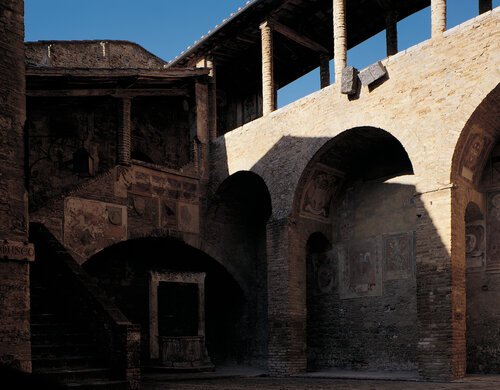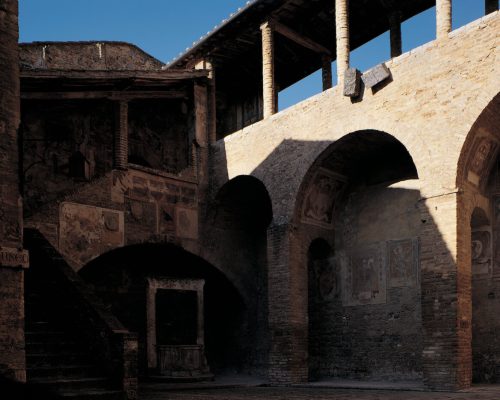The first edition of Arte all'Arte, curated by Laura Cherubini, explored reality, perception and energy, using essential forms and spatial relationships to challenge time and matter. Getulio Alviani in Siena explored dynamism and visual perception, where the interaction between work and viewer is constantly evolving. In San Gimignano, Giovanni Anselmo integrated energy, matter and processes through concrete and radical works. The art of Luigi Ontani, between myth, identity and transformation, was the protagonist in Montalcino and Michelangelo Pistoletto used the mirror to fuse self-portrait, spectator and infinity within the walls of Volterra. This edition was an experience to reveal the conventions of the visible by mixing tradition and culture - personal and collective - between the ancient and the contemporary.
Edited by Laura Cherubini
“La realizzazione delle prime opere ci sembra quasi un miracolo, e sono bellissime. Ontani a Montalcino lavora come di consueto sulla vocazione del luogo in cui il vino è il prodotto più tipico. All’inizio Ontani aveva anche pensato di coinvolgere il poeta Valentino Zeichen (per il quale ha coniato il titolo “Valentino, sesso e vino”), accompagnato da un coro di voci bianche in canti sul vino, poi la collaborazione si limita ad alcuni versi in catalogo. Lo scarno lavoro di Anselmo, è fatto di pochi e semplici elementi, ma tra essi passa una grande corrente di energia, il principio vitale della materia. L’opera è composta in una coppia di pietre verso un tentativo di volo. Alviani lavora a Siena e dedica l’opera al Palio, ma, da protagonista dell’arte cinevisuale, non si interessa di cavalli e fantini, ma dell’apparato visivo di contorno: bandiere, biglie, coccarde, stemmi coi colori delle contrade che si prestano a mille giochi ottici per opaliop, un Palio optical generato da una serie di rispecchiamenti. E quanto si arrabbiò Get quando seppe dai “ragazzi” che i Priori e il regolamento del Palio non permetteva l’uso del materiale originale! Ci volle tutta la pazienza di Anna per calmarlo! Ma si rilassò tanto che nel ormai famoso bus di Art to Art, cantava “Abat-jour”… Pistoletto progetto per la Pinacoteca di Volterra, una sequenza di 5 tronchi: il primo diviso a metà e rivestito nella parte interna con una parete specchiante. Il secondo era tagliato a 90°, con 2 specchi che si raddoppiano per il fenomeno della rifrazione, più l’angolazione del taglio si restringe, più lo specchio si moltiplica, finché alla fine il tronco si ricongiunge e possiamo solo immaginare l’infinita rifrazione al suo interno. Per una strana coincidenza, nell’invito della mostra appare una sequenza di 5 alberi, tratti da un’opera del Beato Angelico, l’artista che coglie l’analogia tra natura e cultura, tra un albero e un corpo umano. Di queste segrete coincidenze è fatto lo spirito di Art to Art che tende a ricostruire un tessuto tra gli artisti e le città, a riannodare i fili con la tradizione artistica del passato in vista del presente.”
Laura Cherubini, dal catalogo di Arte all’Arte X, 2005
"Every work of art is a child of its time but expresses in itself something that goes beyond time. This is certainly what the friends of the Arte Continua cultural association thought when they decided to propose to the attention of four historic Tuscan municipalities, Volterra, San Gimignano, Siena, and Montalcino, the product of the creativity of famous contemporary artists in spaces within which the history of the Italian Middle Ages and Renaissance can be breathed.
A daring event? Not so much, if you consider that art, the real kind, is recognised for its universal language that allows epochs and people far apart in time and space to find themselves close and understand each other.
On the contrary, it is precisely the comparison between works that do not belong to the same period that allows us to develop a reflection on the path that man has taken throughout history, varying yes, expressive techniques, always manifesting new sensitivities, but in the end always remaining the same commitment to seek out and produce what an illustrious and anonymous person from the classical era defined as the sublime."
Renato Bacci, Assessore alla Cultura di Volterra, da Arte All’Arte I





